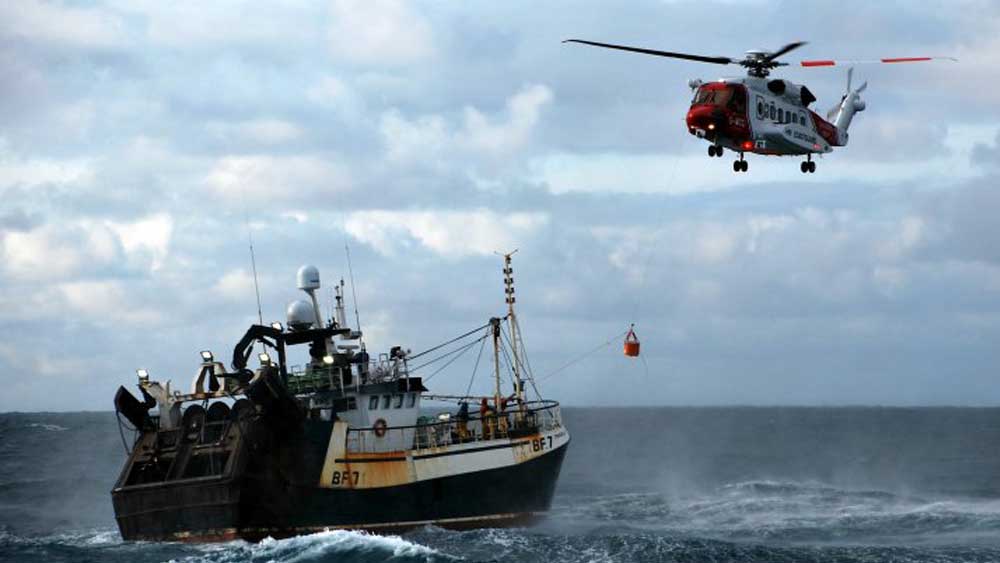In many places of the world, fishing is a dangerous occupation. Consequently, it is a fearful situation when a fishing or shrimping boat, somewhere out in ocean waters, begins to take on seawater faster than the boat’s pump can expel it.2
Somehow seawater invaded the Scotland-registered Tranquility’s fish-hold, so emergency help was urgently called in. And needed help came, quickly.
The Sumburgh-based coastguard helicopter came to the aid of a fishing vessel 30 miles north of Unst this morning (Thursday [June 3rd 2020]) after it began taking in water. Helicopter crew lowered a pump on board the Banff-registered Tranquility after the alarm was raised at 5am. The vessel, which had five people on board when it made its mayday call, is expected to make her own way to Lerwick [Shetland] after the situation was taken under control. The water [had started] coming into the boat via its fish hold.1
It’s a good situation when needed help is quickly provided by more than one nearby source! And that is what happened to the imperiled fishing boat.
The Aith lifeboat was initially called to the scene and was due to escort the vessel, but the Lerwick lifeboat has been tasked to take over. Two other fishing boats including the Mispah LK173, also provided assistance during the incident.1
Of course, avoiding an emergency is to be preferred, if possible.2
But unforeseen or unavoidable circumstances sometimes must be faced. In such perilous times it is good to have help provided.
Christians realize that God is always there to give the help needed.3 Sometimes that need is providentially provided for through helpful humans—such as family, friends, neighbors, or even strangers.4
Even animals sometimes come rushing to the rescue, as first responders who rush to the rescue on hearing a cry for help.5,6
For example, when a large predatory bird attacks a small bird (or its nest of hatchlings), the imperiled bird’s alarm-cry is often followed by a “mob” attack. A crowd of “vigilante” small birds chase and peck the predator, who often flees to avoid the group counter-attack.
This has often been observed in corvid birds—the family of crows—such as Eurasia’s Siberian jay.
Jays sometimes gang up on owls and hawks, their primary predators, in an activity called “mobbing.” Uppsala University research on Siberian jays, slated to appear in the Proceedings of the Royal Society Biological Sciences, investigated the specifics of how jays communicate when mobbing predators. The study found that these birds have “over 25 different vocalisations” which combine to form “over a dozen different calls [while mobbing], some of which are specific for owls and other [sic] for hawks.”5
Likewise, North America has scrub jays, corvid birds that practice mobbing. They do this to provide group protection against a predatory bird or snake.
If scrub jays detect a predator such as a hawk, owl, or large snake, they will mob it, scolding loudly. Scolding attracts other jays in the vicinity as well as other small bird species. Mobbing may include nipping at a sitting hawk or owl or biting the tail of a retreating snake, driving the predator away.6
A friend in need is a friend indeed!
Stage image: Coastguard search and rescue helicopter and Tranquility.
Stage image credit: Ross Robertson. Copyright © 2020. Adapted for use in accordance with federal copyright (fair use doctrine) law. Usage by ICR does not imply endorsement of copyright holders.
References
1. Tranquility (LK 63) is a fishing trawler. Regarding the recent emergency (and rescue) at sea, see Cope, C. 2020. Emergency Services: Fishing Vessel Takes in Water North of Unst. Shetland News. Posted on shetnews.co.uk June 4, 2020, accessed June 5, 2020.
2. Statistics represent real human lives. Near Greenland, en route to North America, the Titanic sank on April 14, 1912, after colliding with an iceberg. During the summer of 2002, not far from Greenland, NCL’s cruise ship Norwegian Dream had left Reykjavik, Iceland, and was aimed at St. John’s in Newfoundland, Canada, when weather reports indicated icebergs and very serious storms, so an alternate course was taken to avoid the risky area. This writer (who was then serving as NCL’s onboard lecturer, teaching Viking history and geography) recalls hearing that a nearby shrimp boat had been overwhelmed by the storm and was lost to the Atlantic Ocean—thankfully after all of its crew was rescued.
3. Psalm 46:1; Matthew 14:30-31; Hebrews 4:16.
4. Proverbs 27:10; Luke 10:25-37. Sometimes providing help to strangers can lead to unexpected outcomes, in some cases ultimately leading to new family relationships and future generations. The Vinland Sagas record how Leif Eiriksson (and his fellow Vikings) once rescued some stranded shipwreck survivors, one of whom later married Leif’s brother. Johnson, J. J. S. 2019. “Snorri Thorfinnsson, First Viking Baby Born in North America, Born to Iceland-born Gudrid Thorbjornsdottir, Shipwreck Survivor Rescued by Leif Eiriksson.” Leif Eiriksson Rekefest Lecture Series. September 28, 2019. Arlington, TX: Norwegian Society of Texas, 8 pages.
5. Thomas, B. Jay Talking. Creation Science Update. Posted on ICR.org June 29, 2009, accessed June 5, 2020.
6. O’Daniel, D. Scrub Jays: The Ultimate Bird Brain. Answers in Genesis. Posted on answersingenesis.org June 23, 2019, accessed June 5, 2020.
*Dr. Johnson is Associate Professor of Apologetics and Chief Academic Officer at the Institute for Creation Research.














